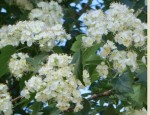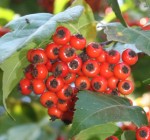 This medium sized deciduous tree is native to southern United States from Virginia to Alabama where it can be found in open woods, stream banks, and rocky areas. It was first commercially grown near Washington, D.C., in the late eighteenth century accounting for its common name. It is one of the showiest of the hawthorns with its abundant clusters of white flowers in late June, its orange and red foliage in fall, and red berries that persist from fall into winter and are eaten by birds. The simple, lobed leaves emerge reddish in spring before turning dark green. The dense, rounded form of Washington hawthorn make it a good specimen tree but it is also attractive when used in groups or screens. It can also be pruned into a hedge but should not be used where children play because of its thorns that are up to three inches long. It grows well in cities and old plantings can be found in areas of New York City. A member of the rose family and related to apples, it suffers from many of the disease that apples do.
This medium sized deciduous tree is native to southern United States from Virginia to Alabama where it can be found in open woods, stream banks, and rocky areas. It was first commercially grown near Washington, D.C., in the late eighteenth century accounting for its common name. It is one of the showiest of the hawthorns with its abundant clusters of white flowers in late June, its orange and red foliage in fall, and red berries that persist from fall into winter and are eaten by birds. The simple, lobed leaves emerge reddish in spring before turning dark green. The dense, rounded form of Washington hawthorn make it a good specimen tree but it is also attractive when used in groups or screens. It can also be pruned into a hedge but should not be used where children play because of its thorns that are up to three inches long. It grows well in cities and old plantings can be found in areas of New York City. A member of the rose family and related to apples, it suffers from many of the disease that apples do.
Type: Deciduous flowering tree
Outstanding Features: Abundant white flowers, bright red fruit
Form: Dense, upright, rounded
Growth Rate: Moderate
Bloom: Corymbs of white five petaled flowers in late spring; red berries in fall persist into winter
Size: 25-30’ H x 20-25′ W
Light: Full sun
Soil: Fertile, moist, well-drained
Hardiness: Zones 4-8
Pests and Diseases: Some resistance to cedar-apple rust; susceptible to apple scab, powdery mildew, leaf spots, fire blight, cankers, borers, lacebugs, leafminers, scale, and caterpillars.
Propagation: Seed (stratification needed); cuttings
Outstanding Selections: ‘Princeton Sentry’ (Almost thornless).
